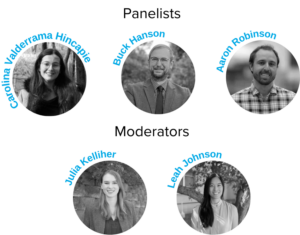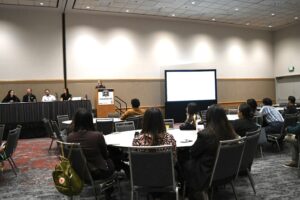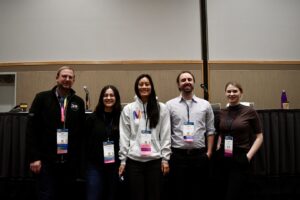Last October, the NMDC team was honored to host a panel discussion at the Society for Advancement of Chicanos/Hispanics and Native Americans in Science (SACNAS) 2023 National Diversity in STEM (NDiSTEM) conference in Portland, Oregon. The panel centered around data management best practices and included an open discussion format for the audience to contribute their experiences. Hosted by NMDC team members Julia Kelliher and Leah Johnson, the panel included undergraduate Carolina Valderrama Hincapie from the University of New Mexico and NMDC Champions, Buck Hanson and Aaron Robinson. We caught up with our panelists to recap their experiences and favorite parts of participating in the 2023 NDiSTEM conference.

NMDC Panelists (top row, left to right: Carolina Valderrama Hincapie, Buck Hanson, and Aaron Robinson) and Moderators (bottom row, left to right: Julia Kelliher and Leah Johnson)
Meet the panelists
Carolina Valderrama Hincapie is a research assistant in the lab of Dr. Vincent Martinson at the University of New Mexico. She completed her undergraduate Honors Thesis studying metabolic and morphological differences between closely related Symbiotaphrina fungi in their free-living versus symbiotic states. Carolina was born in Bogotá, Colombia and moved to the US when she was 19 to pursue a career in research. Her research interests include microbiology, mycology, and molecular biology. Carolina will be starting her PhD this fall in Ecology and Evolutionary Biology at the University of Colorado, Boulder, with a focus on mycology.
Buck Hanson is a 2024 NMDC Ambassador and staff scientist at Los Alamos National Laboratory. Growing up in a small town on the Oregon coast there was little exposure to scientific research careers. As a University of Oregon undergraduate, he explored many areas of science, but gravitated towards microbiology as an interdisciplinary field that intersects diverse tool sets and scientific perspectives. After completing a PhD with a focus on soil microbiology at Cornell University, he moved to Vienna, Austria for a postdoc exploring the human gut microbiome. With a yearning for research with an environmental focus, Buck joined the Bacterial-Fungal Interactions Science Focus Area team at Los Alamos where his work focuses on microbial interactions in plant rhizospheres that contribute to climate resilience and carbon sequestration in arid grasslands.
Aaron Robinson is an NMDC Champion and staff scientist at LANL. Aaron is interested in understanding the ecology and evolution of fungi, how fungi interact with other organisms, and the development of bioinformatics resources for fungal research. He obtained his PhD in biology from the University of New Mexico, making him the first to obtain a PhD in his family. As a scientist at LANL, Aaron continues to promote science within the local Hispanic communities in which he was raised and works with local minority serving institutions to encourage the next generation of scientists from underrepresented backgrounds. As a first-generation PhD student, Aaron is familiar with the barriers and obstacles to pursuing a career in science, and hopes to make science and scientific careers more accessible to people from all backgrounds.
SACNAS 2023 NDiSTEM Experience
What was your favorite part about the SACNAS NDiSTEM conference?
Carolina: My favorite part of the conference was the amount of people that were showing their amazing research. It made me feel nice about having a vast research scientific community that supports each other no matter where they come from and what they are passionate about.
Buck: What I loved about the SACNAS NDiSTEM conference were the opportunities to interact with future leaders in STEM. This was my first time attending SACNAS and I was blown away by the broad range of scientific disciplines represented as well as all of the opportunities for young scientists to engage with each other and get exposure to and make connections for future research, academic, and industry paths.
Aaron: My personal favorite part of the SACNAS NDiSTEM conference was attending talks on such a wide diversity of topics ranging from scientific inclusion to policy. The speakers and panels represented such a breadth of expertise, experience, and backgrounds which was something very unique to NDiSTEM. As a close second – getting to network with so many individuals from different universities, institutions, and companies throughout the conference was great.
What was your favorite part about the NMDC panel discussion?
Carolina: Having the opportunity to share the space with the other panelists, who came from different backgrounds and experiences in science, inspired me to keep pursuing research as a career.
Buck: It was an honor to participate as one of the panelists in the NMDC session on data management practices. The best part was the audience participation and hearing their stories of trial and error and success. I think we all could empathize with each other the challenges in big data management.
Aaron: The audience participation was great for this panel. It was really interesting to hear about some of the challenges others have faced with data management and re-usability. It was also great to see how excited the audience was about the NMDC and some of the features.

Panelists shared their experiences during the session
What is your data management “horror story” and tips or tricks you learned from it that you would like to share?
Carolina: Once, I left my lab notebook on the bench and one of my lab mates accidentally dropped 70% EtOH on the notebook, leaving almost every page of it non readable (the ink bled). Thankfully I had a digital version of all my data, which helped me recover everything easily. It is always important to have backup data for unexpected occasions.
Buck: Over my career, I have worked in different labs across the world. At each of these places, I have left a trail of my data, stored on servers and in lab notebooks. Keeping track of those data and remembering what is stored where has been a challenge. What has saved my life on a few occasions is having a good working relationship with the IT and server managers at each of these former places of work. They’ve helped with forgotten passwords, finding folders that have been archived, and assisting with basic data transfers. Thank you to you all!
Aaron: My data management horror story relates to collecting samples out in the field for genetic studies. During this collection, all the relevant metadata (location, time, sample type, etc…) was all collected in a notebook that was later misplaced before the information could be digitized. This made the samples much less valuable and hard to work with or publish on. The tricks I learned from this are to always digitize and create backups of metadata as soon as possible.
What does open and accessible science mean to you?
Carolina: Open and accessible science means that anyone, from a high school kid to a college professor can access scientific data on the internet or at their school library without any economic cost to them. This would benefit the scientific community by helping spread their findings, and the general public to be aware of scientific advances and awaken their curiosity.
Buck: Open to me means transparency in how data has been collected, processed, and analyzed. As scientists, it is imperative that our work be evaluated by others in our field and that findings are substantiated through reproducibility. In hand with this, data accessibility is increased when others can interpret and understand results; this often is bolstered with sufficient metadata so that the data has context and can be relatable to other data sets.
Aaron: Open and accessible science means to me substantially reducing or completely eliminating barriers that prevent scientific results, data, or opinions from being shared with everyone. Making sure everyone has access to the same resources, tools, and data, regardless of affiliation, funding, or location.

Group photo of the panelists and moderators (left to right: Buck Hanson, Carolina Valderrama Hincapie, Leah Johnson, Aaron Robinson, and Julia Kelliher)
A note from the panel moderators
Participating in the SACNAS 2023 NDiSTEM conference was an exciting opportunity for the NMDC team to connect with researchers across diverse disciplines and backgrounds. We particularly enjoyed hearing scientists connect their personal experiences with their research, such as the SPARK ezine panel to support science communication and storytelling by BIPOC graduate students at the University of Minnesota. Attending and participating in NDiSTEM was one of many engagement efforts the NMDC team has established to ensure we are hearing diverse perspectives in our mission towards making microbiome data FAIR.
As a part of our commitment to engaging with the diverse microbiome research community, we have launched an Inclusion, Diversity, Equity, and Accountability (IDEA) Working Group for the NMDC community which was outlined in our 2024 IDEA Action Plan. Through this group, we aim to stay up to date with resources on inclusive data stewardship and anti-racism, and host open discussions on actionable IDEA goals. Attending and sharing insights from events such as NDiSTEM and the 2024 US Indigenous Data Sovereignty and Governance Summit is a core part of our efforts to expand the resources available to the working group. To join the IDEA working group, please fill out this form to request to join the mailing list and NMDC Community Slack #idea-principles channel. Our next scheduled quarterly meeting is in May 2024, and the group is open to any interested parties. Through this working group and our engagement efforts, we are excited to continue our work towards a more diverse and equitable future for microbiome research.
LA-UR-24-23447
Join our vision
Want more info? Or to be an NMDC Champion? Subscribe to be the first to know about the latest news and developments.
